#american fauna
Text
Section 7 / Continent: South America
General Layout:
Section 7 is set up in a dense jungle with large rivers cutting through it. The majority of the section is enclosed due the its density, and the few clearings that the section has are used for buildings.
The section is marked with pathways, and there are stairs, escalators, elevators that take you up into the trees and bridges that take you across. Guests can also get around the section riding up and down the rivers in small boats.
There's also a wide variety of restaurants, gift shops, and amenities, within the section, including guided jungle expeditions, outdoor rope courses, and wild cat cafes.
The Animals:
Amphibians: Frogs.
Aquatic/Semi-Aquatic Mammals: Capybaras, Elephant Seas, Otters, Sea Lions
Birds: Boobies, Caracaras, Doves, Egrets, Finches, Flamingos, Hawks, Herons, Kiskadees, Lapwings, Owls, Parrots, Sparrows, Spoonbills, Swans, Toucans, and Vultures
Fish: Angelfish, Butterflyfish, Damselfish, Eels, Morays, Parrotfish, Pufferfish, Seahorses, Surgeonfish, Tangs, and Trumpetfish.
Insects: Bees, Beetles, Butterflies, Dragonflies, Grasshoppers, and Mantises.
Misc. Carnivores Animals: Anteaters, Bats, Jaguars, Jaguarundis, Mountain Lions, and Ocelots.
Misc. Herbivorous Animals: Agoutis, Coypus, Deer, Guanacos, Guinea Pigs, Kinkajou, Llamas, Maras, Pacas, Porcupines, Sloths, Tapirs, and Vicuñas, and Viscachas.
Misc. Omnivorous Animals: Alpacas, Armadillos, Bears, Coatis, Foxes, Maned Wolves, Opossums, Peccaries, Racoons, Skunks, Squirrels, and Tayras.
Primates: Capuchins, Howler Monkeys, Marmoset, Squirrel Monkeys, Tamarins, Titis, and Woolly Monkeys.
Reptiles: Caimans, Lizards, Snakes, and Turtles.
---
Amphibians:
Aquatic/Semi-Aquatic Mammals:
Birds:
Fish:
Insects:
Misc. Carnivores Animals:
Misc. Herbivorous Animals:
Misc. Omnivorous Animals:
Primates:
Reptiles:
[The Section Masterpost Link]
#the butterfly's effect#notes#writers on tumblr#current wip#writeblr#writblr#writers#writing#wip#work in progress#zoo#wildlife#south america#south american wildlife#american fauna#american animals#american wildlife
2 notes
·
View notes
Text
Hello Turtle community !
I need help. 🐢
For my upcomming PhD, I need to sample several turtle species to obtain chemical data based on their environment. For that I need to contact rescue centers, sanctuary, etc
I have found rather easily contact informations for sanctuaries working with marine turtles but I struggle to find centers working with Malaclemmys Terrapin. The difficulty is that I need tropical latitudes, so the south of the USA would be great, in coastal areas to have specimens living in brackish waters. The majority on the centers I have found are in NJ or NC.
So if you have informations, it would be great 😁

#turtle#malaclemmys terrapin#diamondback terrapin#terrapin#turtles#turtle rescue center#usa#american fauna
0 notes
Text

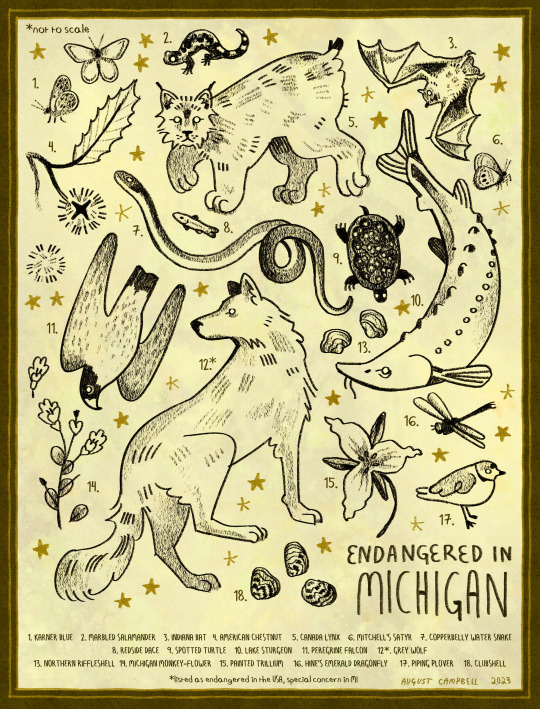
ENDANGERED IN MICHIGAN [redraw]
1. karner blue 2. marbled salamander 3. indiana bat 4. american chestnut 5. canada lynx 6. mitchell's satyr 7. redside dace 8. copperbelly water snake 9. spotted turtle 10. lake sturgeon 11. peregrine falcon 12*. grey wolf 13. northern riffleshell 14. michigan monkey-flower 15. painted trillium 16. hine's emerald dragonfly 17. piping plover 18. clubshell
*listed as endangered in the USA, special concern in MI
#my art#art#endangered species#michigan flora#michigan fauna#michigan wildlife#biology art#conservation#north american wildlife
2K notes
·
View notes
Text
Uncharismatic Fact of the Day
Flamingos aren't just flamboyant for show! Adults are seasonal monogamists, meaning they only form partnerships for a single mating season. However, about 35% of these partnerships deviate from the usual male-female pairing; relationships can also form between two individuals of the same sex, two males and a female or vice versa, or even a group of four in any combination of sex!

(Image: A trio of American flamingos (Phoenicopterus ruber), one juvenile (bottom) and two adults, by Victor Stoll)
If you like what I do, consider leaving a tip or buying me a ko-fi!
#american flamingo#Phoenicopteriformes#Phoenicopteridae#flamingos#birds#uncharismatic facts#queer fauna#nature is queer
94 notes
·
View notes
Text

Fast Fauna Facts #22 - Eastern Dobsonfly (Corydalus cornutus)
Family: Dobsonfly Family (Corydalidae)
IUCN Conservation Status: Unassessed
Like most dobsonfly species male Eastern Dobsonflies like the individual pictured above have enormous mandibles used to impress females, wrestle with rival males and grip partners during mating, but despite their intimidating appearance these mandibles are fairly weak and are unlikely to cause significant injury to humans. Ironically, the much shorter mandibles of females are significantly more powerful, with an adult female Eastern Dobsonfly potentially breaking skin if provoked. While both male and female Eastern Dobsonflies possess impressive jaws neither actually feed as adults, instead spending the entirety of their short lives gathered around shallow slow-moving streams attempting to locate and impress mates. After mating female Eastern Dobsonflies lay eggs on rocks or plants hanging over water, and the newly-hatched aquatic larvae, known as hellgrammites, are born with extremely powerful jaws used to feed on smaller insects as they grow.
----------------------------------------------------
Image Source: Here
<-Previous (Derby's Anomalure) l Next (Three-Toed Amphiuma) ->
#fast fauna facts#eastern dobsonfly#dobsonfly#dobsonflies#insect#insects#arthropod#arthropods#zoology#biology#entomology#invertebrate#invertebrates#north american wildlife
43 notes
·
View notes
Text


I made Miss Beatrice Bear a pair of bloomers out of a scrap of flannel and discovered there is no good way I can find to take a photo of bloomers on a bear plushie
#sewing#handmade#doll clothes#fancy fauna plushies#I think that was my tag for Beatrice and Petunia and the cat who is unnamed?#the tutorial for the bloomers mentioned you could wear them under a skirt#and it wouldn’t add as much volume as petticoats but it would add some volume#so I tried it! in miniature!#Miss Beatrice wear American Girl doll sized clothes#and I did use an (off brand) AG style doll to make the pattern for them
44 notes
·
View notes
Text

A moose feeding on plants growing at the bottom of a lake or slow moving stream. Wild animals of North America. 1918.
Internet Archive
#moose#animals#north american fauna#nature photography#what's for dinner#underwater#nemfrog#1918#1910s
267 notes
·
View notes
Text

"Try me" (2023-4)
Last OC painting of last year, and first into this one ^^ I have this small tradition, of making one last of them as a year closes.
This one was a coloring of a doodle I'd had laying around for literally months, and I ended up quite happy with it.
I've been quite busy, I hope you're all doing well!
#Puma#Cougar#Felines#Awkacomic#Eduardo#Whiskers#HighMountain#OC paintings#2023#2024#Nothofagus-obliqua#animals#South American Fauna
13 notes
·
View notes
Photo

Joseph Stella
Neapolitan Song. 1929
#joseph stella#abstract figurative#flora and fauna#fantastic realism#modernism#italian artist#smithsonian american art museum
104 notes
·
View notes
Text
Section 5 / Continent: North America
General Layout:
Section 5 is comprised of open plains, dense forests, and winding rivers. It has few enclosures and even fewer indoor exhibits.
The section is marked with pathways and hiking trails, guests can also get around the section riding on horseback, ziplines, and boats.
Along with the section's restaurants, gift shops, and amenities, there's also a carnival with a rodeo and circus, workshops, and guided nature walks.
The Animals:
Amphibians: Frogs and Salamanders.
Aquatic/Semi-Aquatic Mammals: Dolphin, Manatees, Otters, Porpoises, Sea Lions, Seals, Walruses, and Whales.
Birds: Blue Jays, Bluebirds, Cardinals, Chickadees, Crow, Dove, Ducks, Eagles, Egrets, Finches, Geese, Gull, Hawks, Herons, Hummingbirds, Magpies, Mockingbirds, Ospreys, Owls, Pelicans, Quail, Robins, Sparrows, Turkeys, Turkey Vultures, Warblers, and Woodpeckers.
Fish: Bass, Carp, Catfish, Mola, Perch, Seahorses, Sharks, and Trout.
Insects: Ants, Beetles, Bees, Butterflies, Dragonflies, Grasshopper, and Moths.
Misc. Carnivores Animals: Anteater, Armadillos, Badgers, Bats, Bobcats, Coyotes, Ferrets, Grisons, Jaguars, Jaguarundis, Lynxes, Margays, Minks, Moles, Mountain Lions, Ocelots, Oncillas, Weasels, Wolverine, and Wolves.
Misc. Herbivorous Animals: Bats, Beavers, Bison, Deer, Goats, Gophers, Ground Squirrels, Groundhogs, Hares, Kinkajous, Marmots, Muskoxen, Olingos, Pacas, Pikas, Porcupines, Prairie Dog, Pronghorn, Rabbits, Sheep, Sloths, and Tapirs.
Misc. Omnivorous Animals: Bears, Cacomistle, Chipmunks, Coatis, Flying Squirrels, Foxes, Mice, Opossums, Peccaries, Raccoons, Rats, Shrew, Skunks, Squirrels, and Tayras.
Primates: Capuchins, Howler Monkeys, Panamanian Night Monkeys, Spider Monkeys, and Tamarins.
Reptiles: Alligators, Crocodiles, Lizards, Snakes, and Turtles.
---
Amphibians:
Aquatic/Semi-Aquatic Mammals:
Birds:
Fish:
Insects:
Misc. Carnivores Animals:
Misc. Herbivorous Animals:
Misc. Omnivorous Animals:
Primates:
Reptiles:
[The Section Masterpost Link]
#the butterfly's effect#notes#writers on tumblr#current wip#writeblr#writblr#writing#wip#work in progress#zoo#wildlife#north american wildlife#american animals#american wildlife#american fauna
1 note
·
View note
Text









A nice walk before the rain started this morning. Lots of animals out and about enjoying Spring.
#wildlife photography#wild animals#animals of tumblr#animal photography#toronto#wildlife pictures#wildlife#animals#fauna#wild and free#wild and wonderful#torontoparks#urban landscape#urban wildlife#dawnredwoodleaf#red squirrel#american robin#red winged blackbird#wild fungi#eastern grey squirrel
9 notes
·
View notes
Text

The Western Honeybee often blends in very well with the blossoms it visits.
#american southwest#desert#arizona#davideragland#photography#art#western honeybee#flora and fauna#photografy#beautiful photos#photographers on tumblr#original photographers
8 notes
·
View notes
Text


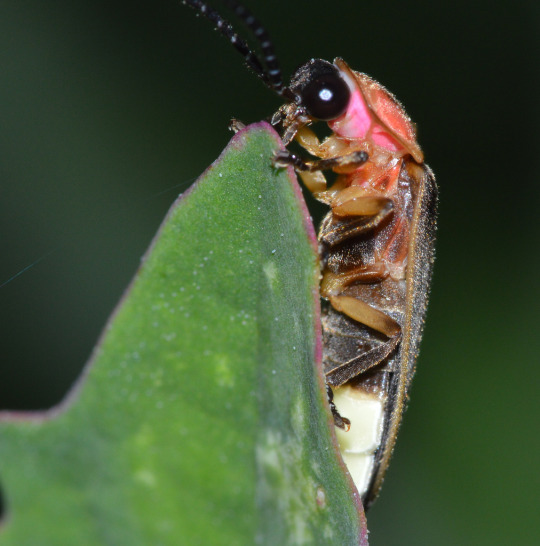
A Night Out with the Eastern Firefly
The eastern firefly, or North American firefly (Photinus pyralis), is a popular sight throughout the United States and southern Canada east of the Rocky Mountains. They are commonly associated with the beginning of summer, as they spend the winter hibernating underground and emerge only when the weather begins to warm. They are commonly seen in deciduous forests, grasslands, gardens, and backyards.
Contrary to their name, the eastern firefly is actually a type of beetle with well-developed wings. Adults are quite small, only 10-14 mm (0.39-0.55 in) long. They have a yellow and red head and a dark brown body with a narrow yellow stripe marking the outline of the wing casings. The main difference between the two sexes is the length of their wings; males have longer wings and are capable of flight, while females have shorter, less functional wings. Both sexes have a special organ on the end of their abdomens that produce light; however, the female's light tends to be weaker. The North American firefly produces its light by combining oxygen with a chemical called luciferin; the resulting chemical reaction gives off a glow which is amplified by special reflective cells in the firefly's abdomen.
Like all fireflies, P. pyralis uses its light producing ability to attract a mate. Males flash only while flying, in bursts about 6 seconds apart. Once a female signals her interest-- also by flashing-- the male lands near her and offers her a package called a spermatophore made of sperm, protein, and nutrients. If the female accepts, she inseminates herself and buries the rest of the package with her clutch of about 500 eggs. These eggs, which glow slightly during development, hatch about 4 weeks after being laid, and the larvae feed on the remains of the nutrient-rich spermatophore. The larvae can take one or two years to develop, and spend most of their time underground or near sources of fresh water like lakes and streams. Once the larva pupates and develops into an adult firefly, they only live in this stage for about a month before dying.
Both larva and adult eastern fireflies are predators, feeding on other insects like worms, snails, and other fireflies. However, larva spend almost all their time hunting for food, while adults spend the majority of their time seeking out a mate. To avoid predation, P. pyralis can emit foul-smelling odors and excretion of sticky substances; they also emit a chemical called lucibufagin that repells spiders. However, other species of fireflies will actually mimic the light patterns of the eastern firefly in order to predate upon them.
Conservation status: The North American firefly is currently considered Least Concern by the IUCN. However, they are threatened by light pollution, pesticides, and habitat loss.
Photos
Judy Gallagher
Katja Shultz
Sydney Penner via iNaturalist
#eastern firefly#north american firefly#Coleoptera#Lampyridae#rover fireflies#fireflies#beetles#insects#arthropods#deciduous forests#deciduous forest arthropods#grasslands#grassland arthropods#urban fauna#urban arthropods#animal facts#biology#zoology#ecology
144 notes
·
View notes
Text

Fast Fauna Facts #11 - Scarlet Macaw (Ara macao)
Family: Macaw Family (Psittacidae)
IUCN Conservation Status: Least Concern
Like other macaws the Scarlet Macaw's bill is large, powerful and unusually flexible, allowing it to manipulate and break hard fruits and seeds when feeding. Scarlet Macaws have frequently been observed using this ability to feed on hard unripe fruit, and as most other fruit-eating animals in their range are unable, or unwilling, to feed on such fruits it has been suggested that this is an adaptation that allows them to access food sources their competitors cannot. Many unripe fruits contain chemicals called tannins which are bitter-tasting and weakly acidic in order to discourage animals from eating them until the seeds within them are mature and ready to be spread, and the acidity of the tannins they eat may explain why Scarlet Macaws have occasionally been observed engaging in geophagy (the act of swallowing soil, rocks or, in the case of Scarlet Macaws, clay), as most clay is weakly alkaline and therefore may help to neutralize the tannins and make them easier to digest.
-----------------------------------
Image Source: Here
<-Previous (Rhubarb) I Next (Century Plant)->
#fast fauna facts#scarlet macaw#bird#birds#parrot#parrots#animal#animals#zoology#biology#ornithology#wildlife#south american wildlife#central american wildlife#north american wildlife
34 notes
·
View notes
Video
undefined
tumblr
(X) <-
#jaguar#big cat#big cats#animal#animals#fauna#video#animal videos#animal video#jaguars#feline#south american animals
168 notes
·
View notes
Text




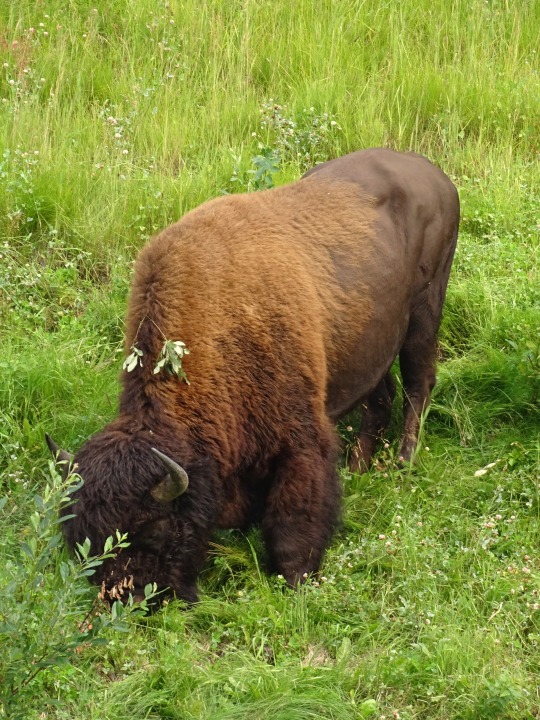

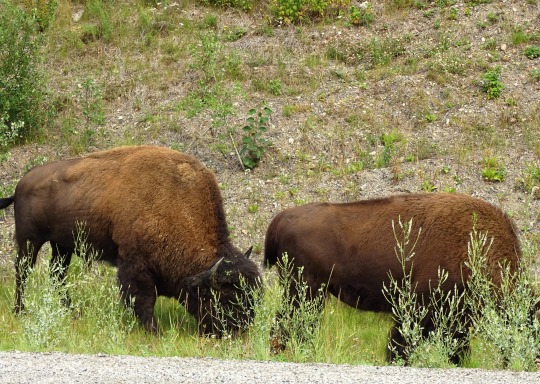
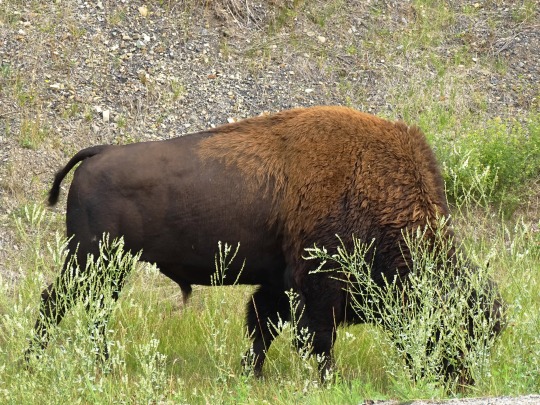
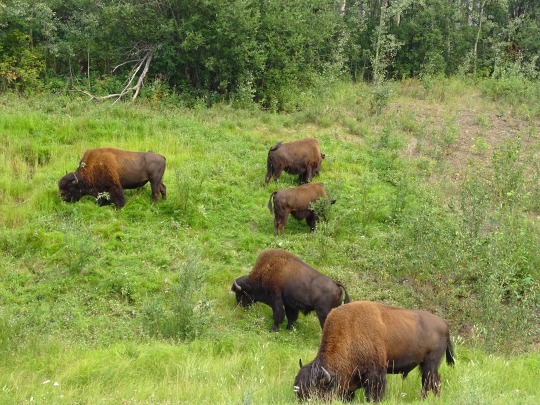
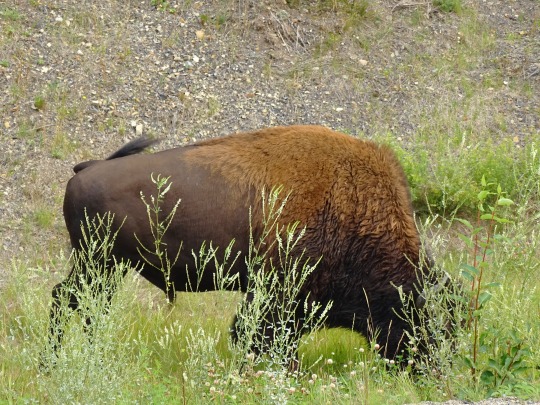
Wood Bisons, YT (No. 3)
The herd currently has a total population around 2,500, largely as a result of conservation efforts by Canadian government agencies. In 1988, the Committee on the Status of Endangered Wildlife in Canada changed the subspecies' conservation status from "endangered" to "threatened", where it remains.
On June 17, 2008, 53 wood bison were transferred from Alberta's Elk Island National Park to the Alaska Wildlife Conservation Center in Anchorage, Alaska. There they were to be held in quarantine for two years and then reintroduced to their native habitat in the Minto Flats area near Fairbanks, but this plan was placed on hold. In May 2014, the U.S. Fish and Wildlife Service published a final rule allowing the reintroduction of a "non-essential experimental" population of wood bison into three areas of Alaska. As a result, the Alaska Department of Fish and Game introduced the first herd of 100 animals to the Innoko River area in western Alaska in spring 2015.
Currently, about 7,000 wood bison remain in wildernesses within the Northwest Territories, the Yukon, British Columbia, Alberta, and Manitoba.
Source: Wikipedia
#Wood Bison#Alaska Highway#travel#original photography#vacation#landmark#landscape#countryside#summer 2023#flora#nature#Canada#Alaska-Canadian Highway#ALCAN Highway#Alaskan Highway#the North#Yukon#tourist attraction#fauna#wildlife#animal#grazing#meadow#Bison bison athabascae#mountain bison#wood buffalo#mountain buffalo#American bison#wildflower
8 notes
·
View notes